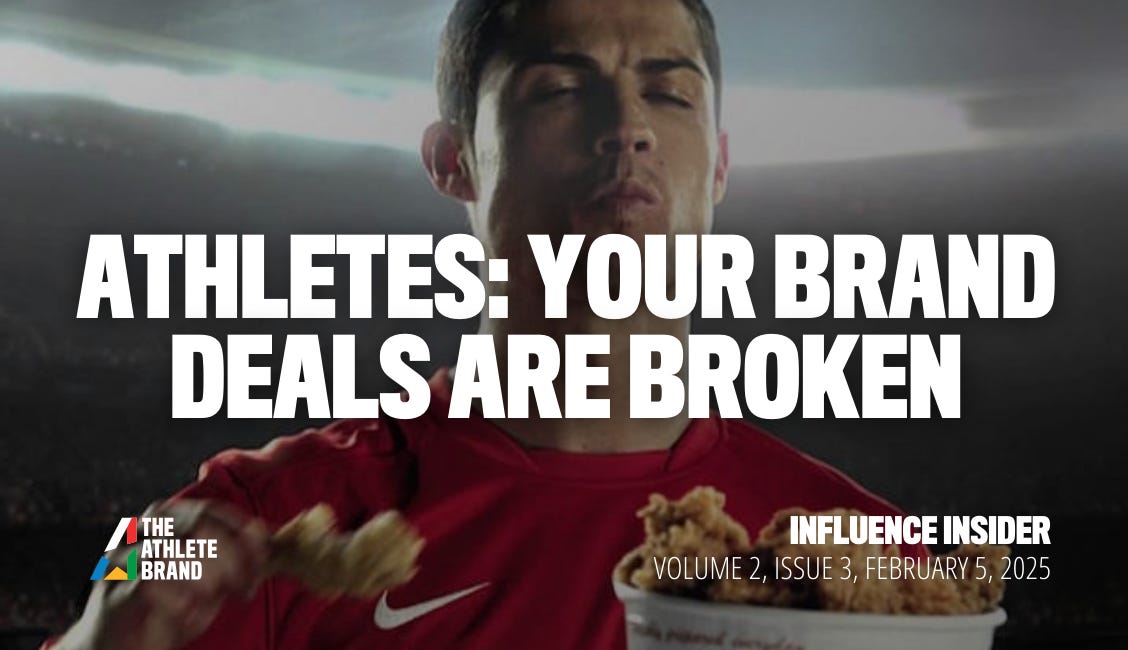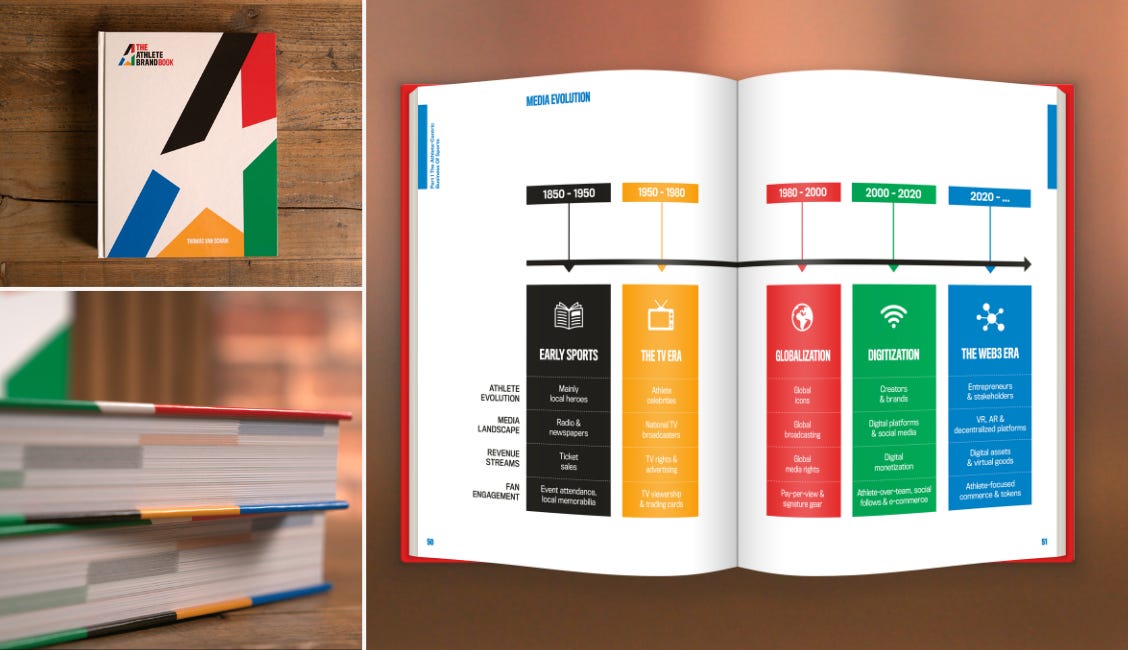Dear Insider,
The sports industry is shifting: fast! Every year, brands spend billions on sponsorships, but here’s a question: when was the last time you actually noticed who sponsors a team’s shirt or clicked on a pitch-side URL? Exactly. The way people engage with brands has changed, and athletes who still rely on outdated visibility models are missing huge opportunities.
This month’s feature explores why influence; built on credibility, connection, and trust, is now the real currency of athlete branding. If you’re still treating your platform like a billboard, it’s time to rethink your approach.
We’re also highlighting two must-read articles: "How social justice movements are reshaping athlete sponsorships," showing how brands now prioritize authenticity over exposure. "Generation TikTok: How female athletes dominated digital engagement during the Paris Olympics," proving that storytelling and influence now drive branding success.
Would love to hear your thoughts: let’s push the conversation forward.
Best,
Thomas
ATHLETES: YOUR BRAND DEALS ARE BROKEN
Here’s how to fix them
For decades, sports sponsorship has been built around selling brand exposure. Companies have poured billions into shirt sponsorships, perimeter boards, and TV placements, believing that more visibility equals more value. More recently, athletes have started monetizing their own platforms, selling reach in the same way most traditional sports properties used to. Most NIL (Name, Image, and Likeness) deals today operate on this principle: an athlete’s value is calculated by reach multiplied by engagement.
But this model is no longer as effective as it once was!
The lost value of exposure
The way people process brand messaging has changed. Donald Broadbent’s filter theory suggests that we absorb only a fraction of what we’re exposed to daily. We are bombarded with branded content, forcing us to tune out much of it. Try this test: How many people in your inner circle can name the jersey sponsor of FC Barcelona, Borussia Dortmund, or Tottenham Hotspur? How often do fans consciously register perimeter board ads or visit the URL they might see on a pitch-side banner?
While repeated exposure might reinforce awareness, it holds little value unless it’s part of a broader narrative that builds credibility, connection, and long-term relevance. Without context and engagement, random logo placements become just another ignored message: blending into the noise rather than standing out.
The opportunity for athletes
Unlike static logos on shirts or stadium banners, athletes have an engaged audience that actively listens to them. They aren’t just seen; they are followed, interacted with, supported, and trusted.
This is where the Know, Like, Trust framework comes in:
✅ Know: Athletes build recognition through their performances and public presence.
✅ Like: They deepen connections by sharing personal stories and engaging authentically.
✅ Trust: Consistency, transparency, and alignment with values turn fans into loyal supporters; and ultimately, customers.
The power of connection
Insights from the book You Do You by Nele Pieters and Stephanie Duval emphasize that athletes who focus on a niche that genuinely resonates with them attract and provide real value to an audience that values them most. This aligns with Kevin Kelly’s 1,000 True Fans theory, which I have discussed often: a smaller, engaged, loyal audience can be far more valuable than a vast, disconnected one.
This is why athletes across all sports and territories, even those in more niche sports, from smaller markets and with smaller audiences, have incredible potential. The key lies in intentional choices, authentic storytelling, and long-term value creation rather than random, short-term monetization.
Be wary of short-term money grabs
Unsupported sponsored posts and opportunistic brand deals will likely be ignored. Moreover, they dilute the reputation, trust, and associations that athletes have built for years. Instead of merely selling reach, the future is about the value of credibility and expertise. The most valuable athlete partnerships:
Align with the athlete’s genuine interests
Are built on long-term brand attributes
Create valuable content instead of just displaying logos
Leverage the trust factor between athlete and audience
The future: “You Do You”
This marks a shift toward a model built around athlete identity and personality. Rather than trying to be “whoever their audience demands them to be” or “acting like they believe athletes are supposed to behave,” athletes are now empowered to just be themselves! Forget about placing the fan first. When “you do you,” your vibe attracts your tribe. You’ll “attract the best and repel the rest.”
Unlike traditional marketing, where brands develop products first and attract customers later, athletes already have a built-in, engaged audience. Instead of selling visibility, they can create and sell products their fans actually want: merchandise, training programs, exclusive content, and events. The best athlete-entrepreneurs will develop partnerships, products, and services for their fans, not the other way around.
Final thoughts
The way we consume and interact with brands has changed. Traditional sponsorship models are fading as audiences filter out irrelevant advertising. Athletes who take a long-term approach, invest in brands they believe in, and expand their brand beyond their athletic ability will create lasting value. The real question isn’t how many people see your name; it’s how many people actually listen to what you have to say.
How social justice movements are reshaping athlete branding and sponsorships
Activism is no longer just a side note in sports; it’s a driving force in athlete branding. As sponsors shift their focus from exposure to impact, socially engaged athletes secure stronger, long-term deals. This article explores how branding strategies are evolving to prioritize authenticity, influence, and deeper fan connections.
⭐⭐⭐
Generation TikTok: How sportswomen set the bar higher than the men
(Published by The Guardian, written by Emma John
The 2024 Paris Olympics proved that female athletes dominated social media—outpacing their male counterparts in engagement, relatability, and influence. This article highlights how authenticity, digital storytelling, and community-building redefine athlete branding.
⭐⭐⭐⭐
Manager, Athlete Marketing & Olympian Legacy
Canada, Montreal, QC
International Olympic Committee – IOC
Switzerland, Lausanne, Vaud
Manager, Legal - Athlete Partnerships (NBA, NFL, Combat)
USA, Coppell, TX
Manager, Legal - Athlete Partnerships (Soccer)
USA, New York, NY
Singapore, Singapore
Israel, Holon, Tel Aviv District,
Turkye, Greater Istanbul
Senior Specialist Sports Marketing - EM South
South Africa, Cape Town, Western Cape
Red Bull
Sports Marketing & Content Trainee - Red Bull HQ Graduate Program
Austria, Elsbethen, Salzburg
Get your copy of The Athlete Brand Book
Boost your brand and amplify your influence, income, and impact with our definitive 600-page guide. Packed with actionable strategies, expert insights, and real-life examples, it's the world's most comprehensive book on athlete branding.
Support our growth
We're expanding and need your help! If you know any podcasts, public speaking workshops, or lectures that could benefit from my expertise, please recommend them to me. Your introductions help us empower more athletes and partners worldwide. E-mail me at: thomas@theathletebrand.com. 📨
Spread the word
Enjoyed this Insider? Forward it to your network and help us build a community of empowered athletes and partners. If I can be of service, or you feel there are people I should get to know, please feel free to shoot me a message. 🧡








